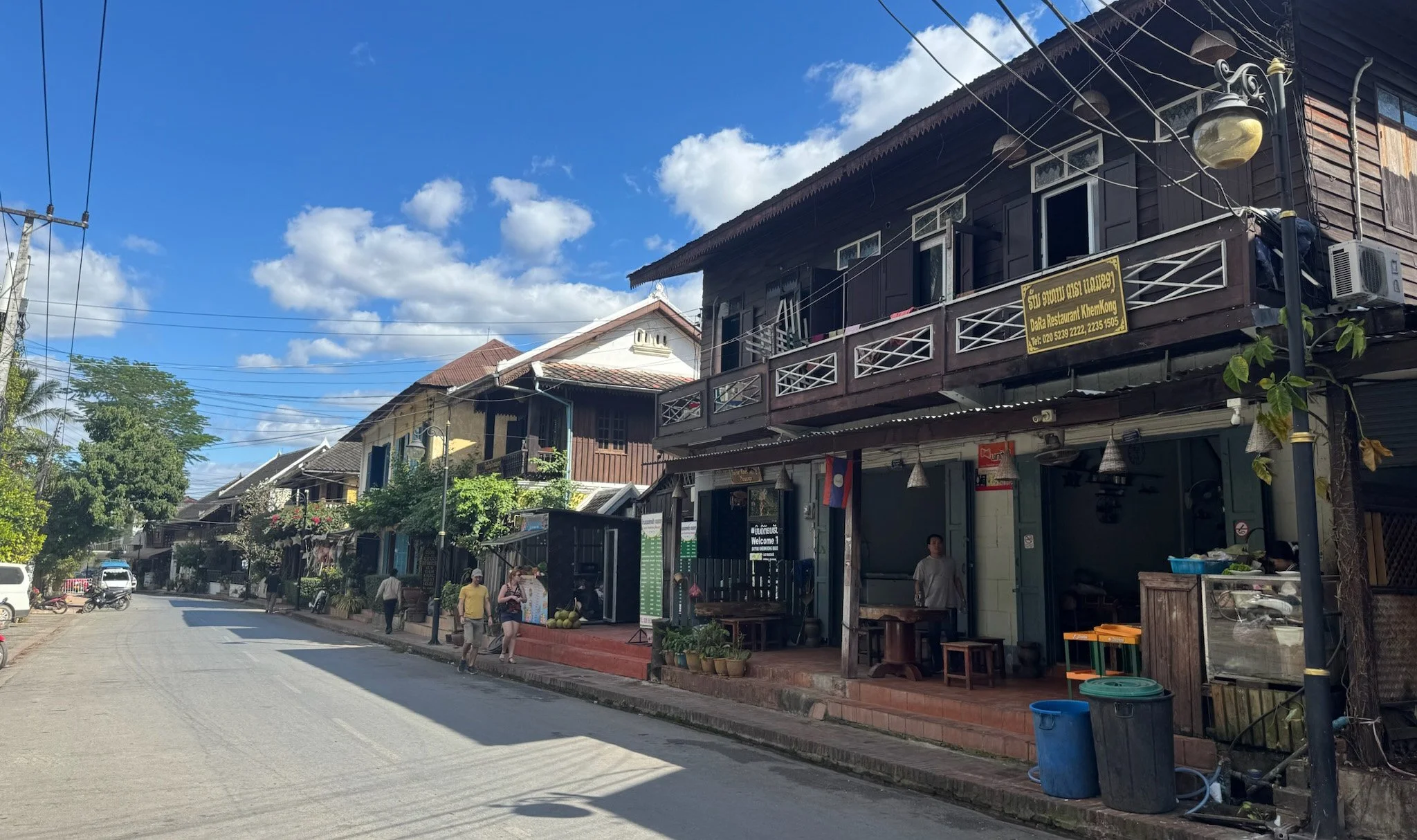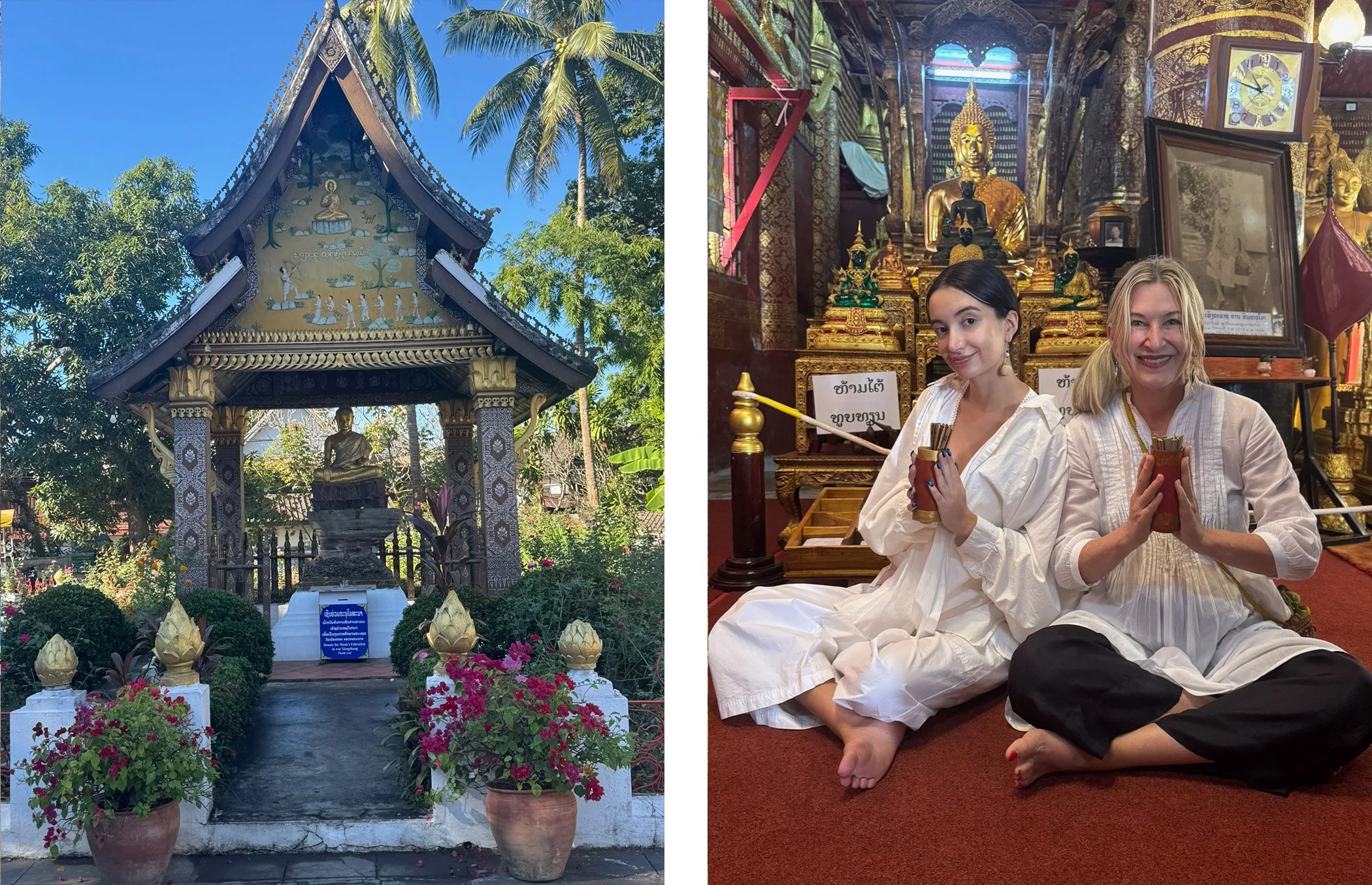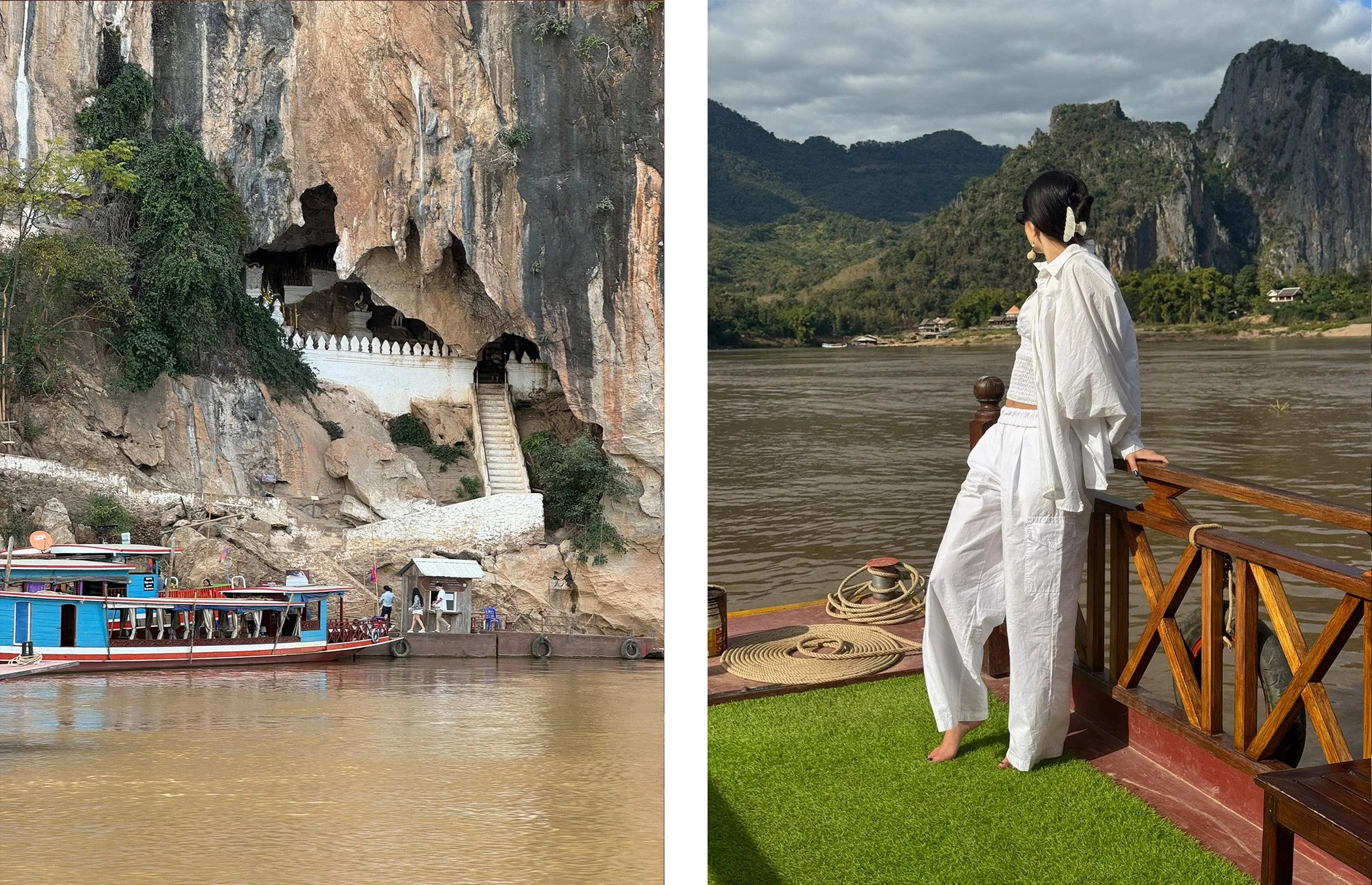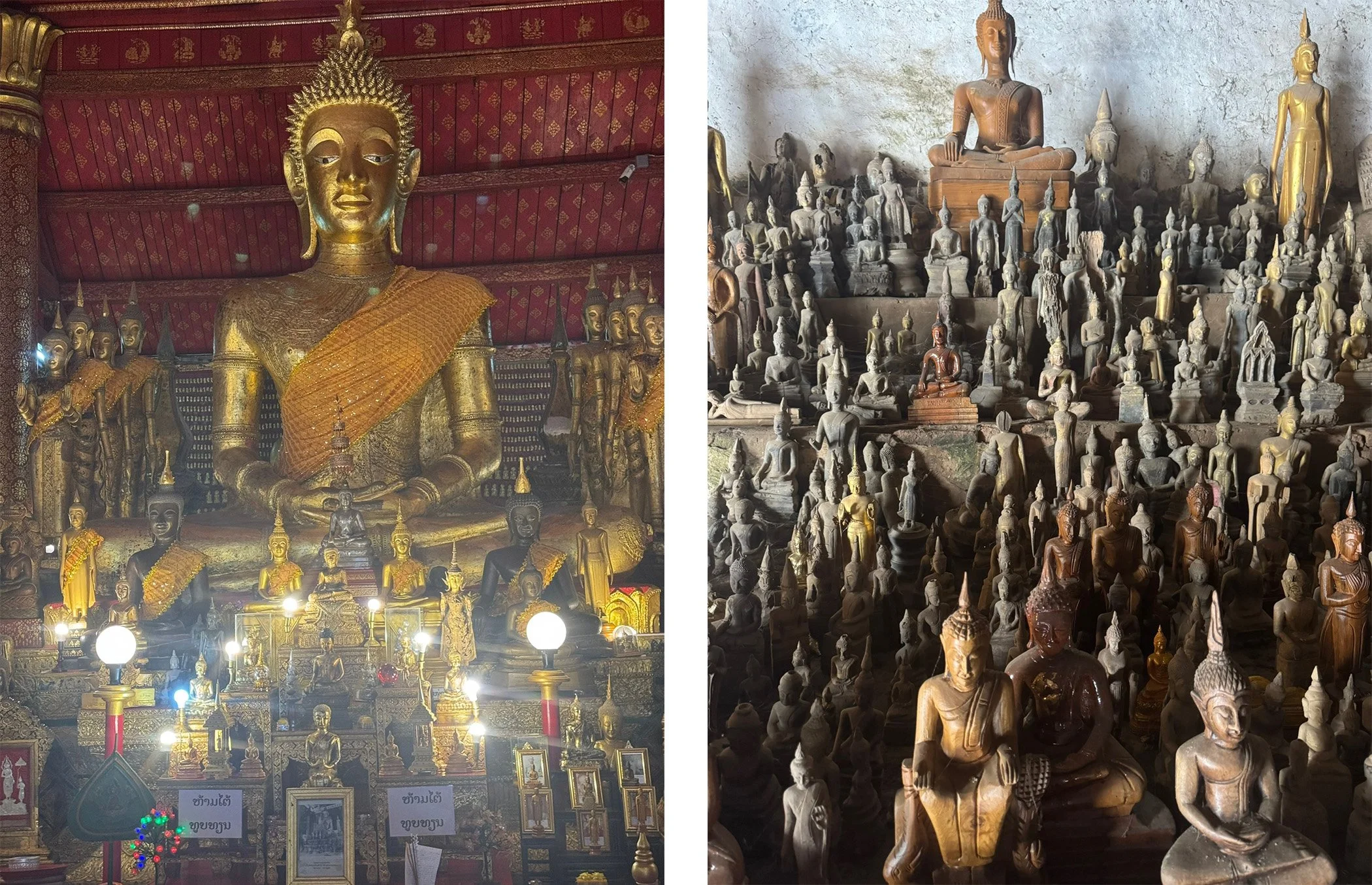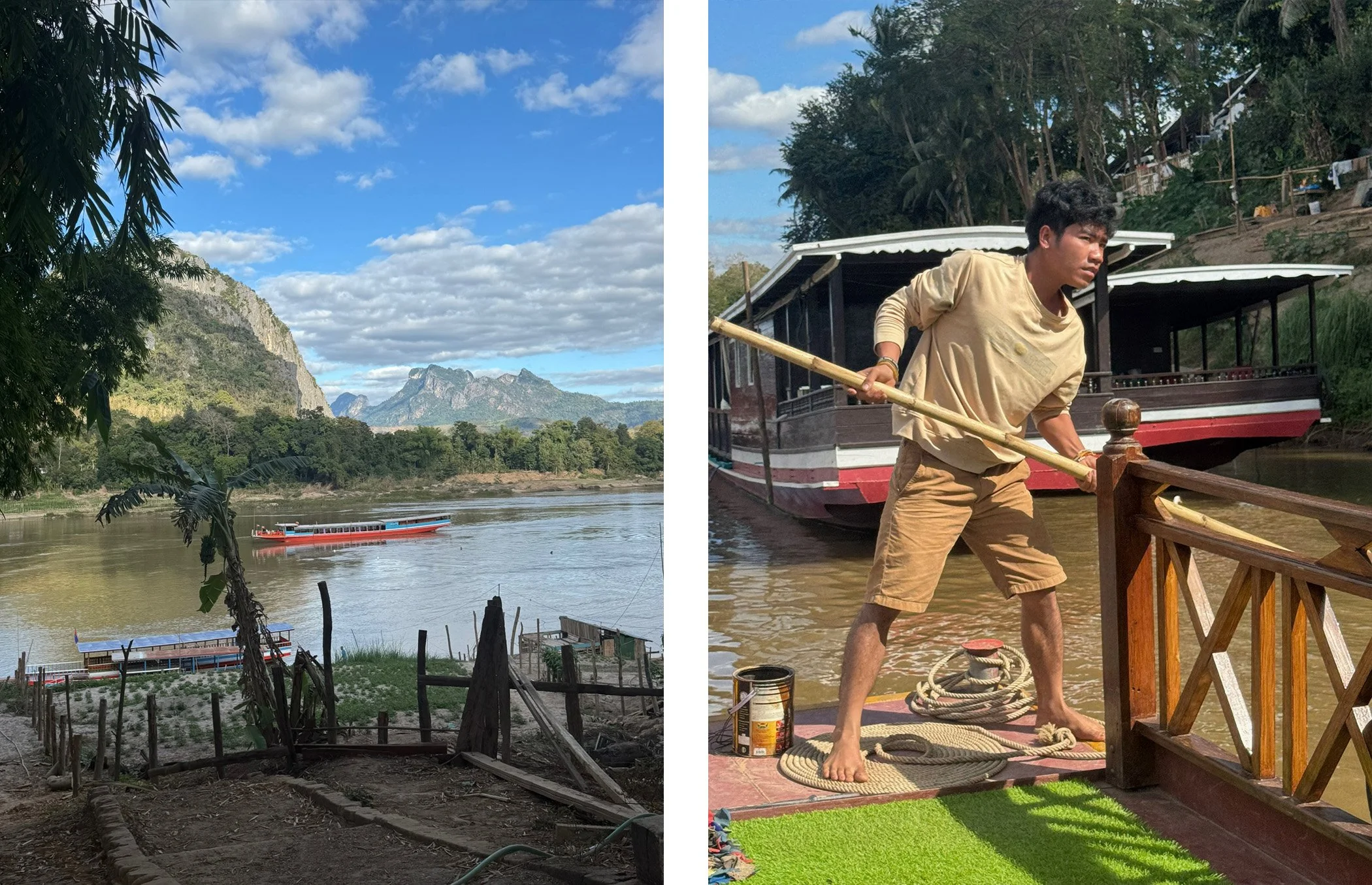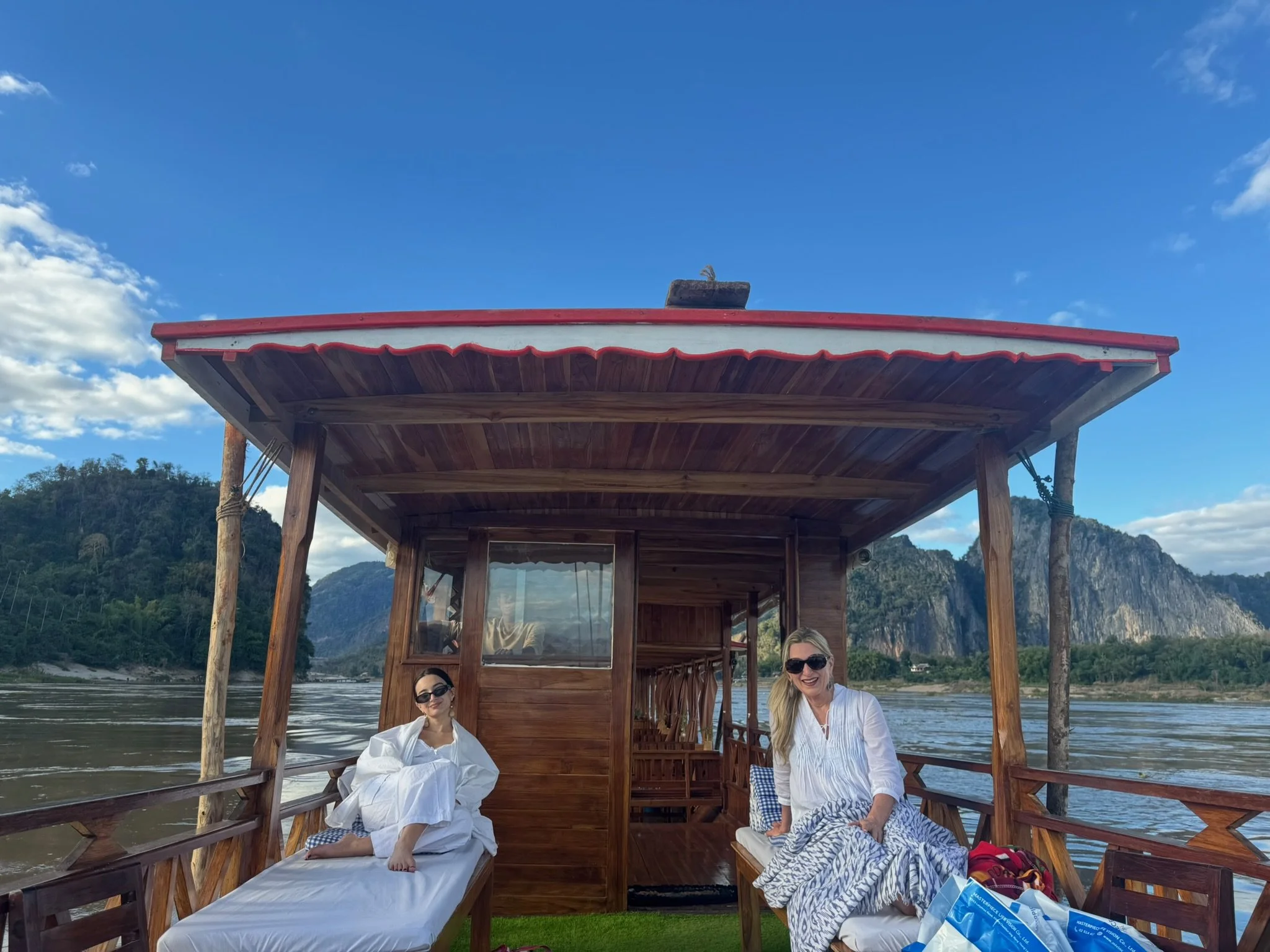Luang Prabang, Laos: 3 Enchanting Days in the City of Timeless Charm
As soon as Roxy and I step foot in Laos, a delightful blend of coconut and lemongrass fills the air, inviting us to explore its hidden wonders. Nestled between the Mekong and Nam Khan Rivers, the UNESCO World Heritage city of Luang Prabang radiates charm with its harmonious fusion of Lao and French Colonial architecture. Once the royal capital until 1975, when a communist revolution toppled the 600-year-old monarchy, this city whispers tales of a bygone era through its gilded temples, saffron-clad monks, and faded Indochinese villas, all set against the backdrop of serene river vistas.
Upon our arrival, we settle into the charming Satri House, a hotel that pays homage to Laos’ past when kings ruled, and the French had influence. Formally the childhood home of Prince Souphanouvong, this splendid retreat is a masterpiece of design, combining intimacy with grandeur. Our room, with its creaky polished wood floors is adorned with exquisite dark wood furnishings, sepia photographs and a sumptuous four-poster bed draped in billowing white nets. The effect somehow manages to be subtly chic, yet grand all at once.
After dropping off our bags, we indulge in a flavorful lunch at the hotel’s open-air restaurant. We savor Lao Feu, a dish that puts a delightful spin on traditional pho, featuring rich buffalo broth, rice noodles, and vibrant fresh herbs. Accompanied by Madame Lamphoune’s Salad, made with chicken, green papaya, and peanuts, every bite transports us deeper into the heart of Laotian cuisine.
Feeling satiated, we venture to the serene spa for a blissful massage, followed by a refreshing dip in one of the hotel’s two pools. With the main pool nestled in the shade of the royal house and the other mere steps from the spa, we find our own little slice of paradise in this petite palais.
As evening falls, we meet our guide, Nan, who leads us through the bustling night market of Luang Prabang. The city’s vibrant side streets are filled with stalls offering a feast for the senses. The aroma of street food mingles with the sounds of local music and happy chatter. With Nan’s expertise, we navigate the myriads of local delicacies, as he explains the various ingredients and cooking methods used in Lao cuisine. Our culinary adventure culminates in a delectable dining experience at Dyen Sabai Restaurant and Bar. Here, we recline on pillows and enjoy a delicious Sindad BBQ, grilling sliced pork at our table, while the flavorful broth simmers with the drippings—an unforgettable fusion of Korean BBQ and hot pot that’s uniquely Laotian.
At 5am, we are greeted by Nan who takes us to Tak Bat, the morning alms procession. Roosters crow as we join the local community and other visitors who line residential streets near the temple to give alms to the saffron clothed monks. The ceremony begins at dawn, a time associated with peace and tranquility, emphasizing the sacredness of the ritual. We quietly wait in the dark on toddler-size plastic stools, wearing white and holding baskets filled with sticky rice.
After a few minutes, robed monks appear in the early morning light. Eyes cast to the ground; we humbly give them our offering. In gratitude, they chant to us in low tones. We are awash in emotion as these spiritual young men with their egoless devotion practice meditation while walking. Since 8000 BC people have been here giving alms to the monks. We are awestruck having now been part of this history.
Afterward, we explored the Royal Palace Museum, where time stands still, revealing glimpses into the life of the last Laotian king. The building and surrounding grounds were built in 1904 during the French colonial era. The museum has preserved the bedrooms and living quarters as they were in 1975, offering a peek into the lifestyle of the last King, Sisavang Vatthana, and his family. There are royal artifacts and wide collection of religious objects, weapons, gifts, art and a not-to-be-missed antique car collection.
Wandering through streets lined with French Colonial architecture, we learn from Nan about the extraordinary longevity of the Laotian people. “My grandfather lived to 116, and my grandmother just died at 122.” We look at him in disbelief. “How did they live so long?” Roxy asks. “They walked, they gardened, they had a community, and they ate very healthy food, mostly vegetables.” Roxy is impressed. “I love the food here; I get how you could live a long life eating like this every day. Last night’s barbeque was one of my favorite meals—ever—and it was totally healthy.”
Our adventure continues at Wat Xieng Thong, a stunning Buddhist monastery that stands as a testament to Laos’s rich spiritual heritage. Retaining its original vibrant decorations dating back to 1560, the temple is a beautiful place to visit. Nan, a former monk who these days prefers Gucci and Dior to saffron robes, shows us how to use the I Ching. Sitting on the temple’s red carpet together, Nan invites us to shake the Fortune Sticks until one falls out.
I pull number 6 for good friends and a long healthy life filled with love, family, and friends. Nan reads from the Paper Oracles, “Robin, your fortune says that your husband will spend the rest of your life with you, forever.” Roxy pulls number 22 for good luck. “Roxy, you will make billions in future, and there’s a good chance that a good man is coming to your life. Everything that you’ve lost you’re going get back. Your enemies are going to come back to you as friends, and you’ll take trips all over the world,” Nan says.
More good fortune awaits us on the Mekong River, where we set off on a private long-tail boat to the famed Pak Ou Caves. But, before we climb aboard, Nan takes us to the Obama Coconut Café. He proudly tells us, “Obama, your American president, once ate here.” A bit skeptical about places that feel more about the marketing than the food, I tell Nan to order for us. For a grand total of $21, we eat papaya salad, larb chicken made with lemon grass, kaffir lime, salt, sugar, and mint, baskets of sticky rice, Laos sausage freshly made daily and morning glory sautéed in garlic. The flavors are incredible, fit for a president, and we savor every bite.
As we cruise along the Mekong, we are mesmerized by the beauty of the landscape, dotted with traditional Laotian villages and fishermen at work. The tranquility of the river embraces us, as we feel the stress of modern life melt away. Our exploration leads us to the Pak Ou Caves, which houses approximately 4,000 sacred Buddhist statues and images ranging from mere inches up to 7 feet in height. “This is giving me Raiders of the Lost Ark vibes,” Roxy says.
Further down the river, in the peaceful village of Ban Muang Keo, we marvel at the artisans preserving their age-old crafts. From weaving beautiful textiles to distilling traditional whisky, each encounter deepens our appreciation for the rich cultural tapestry of Laos, making us feel like true explorers on an unforgettable journey.
There’s a quiet, calm on this mighty river where the mountains rise up to meet the shore. As we make our way back to the city, hatched and primitive dwellings are replaced by French colonial houses, a gentle breeze touches our faces, and the sun is low in the sky with a soft covering of clouds as the water churns gently beneath us. Water buffalos swim across the river and fisherman throw out their lines. With the exception of an occasional telecommunications tower, there are no signs or markers of progress or modernism. Far away from home, Roxy is basking in the warm glow. After two years of non-stop work, she looks peaceful and serene.
As our river cruise comes to an end and we prepare to bid farewell to our wonderful guide, Nan, a wave of gratitude washes over us. Luang Prabang has captured our hearts, leaving us with memories of breathtaking landscapes, delicious food, and the warmth of its people. For those who can't make it to Laos, let this be an invitation to dream and wander through the tales of this enchanting destination from the comfort of your armchair. The spirit of Luang Prabang awaits, ready to inspire your next adventure.






